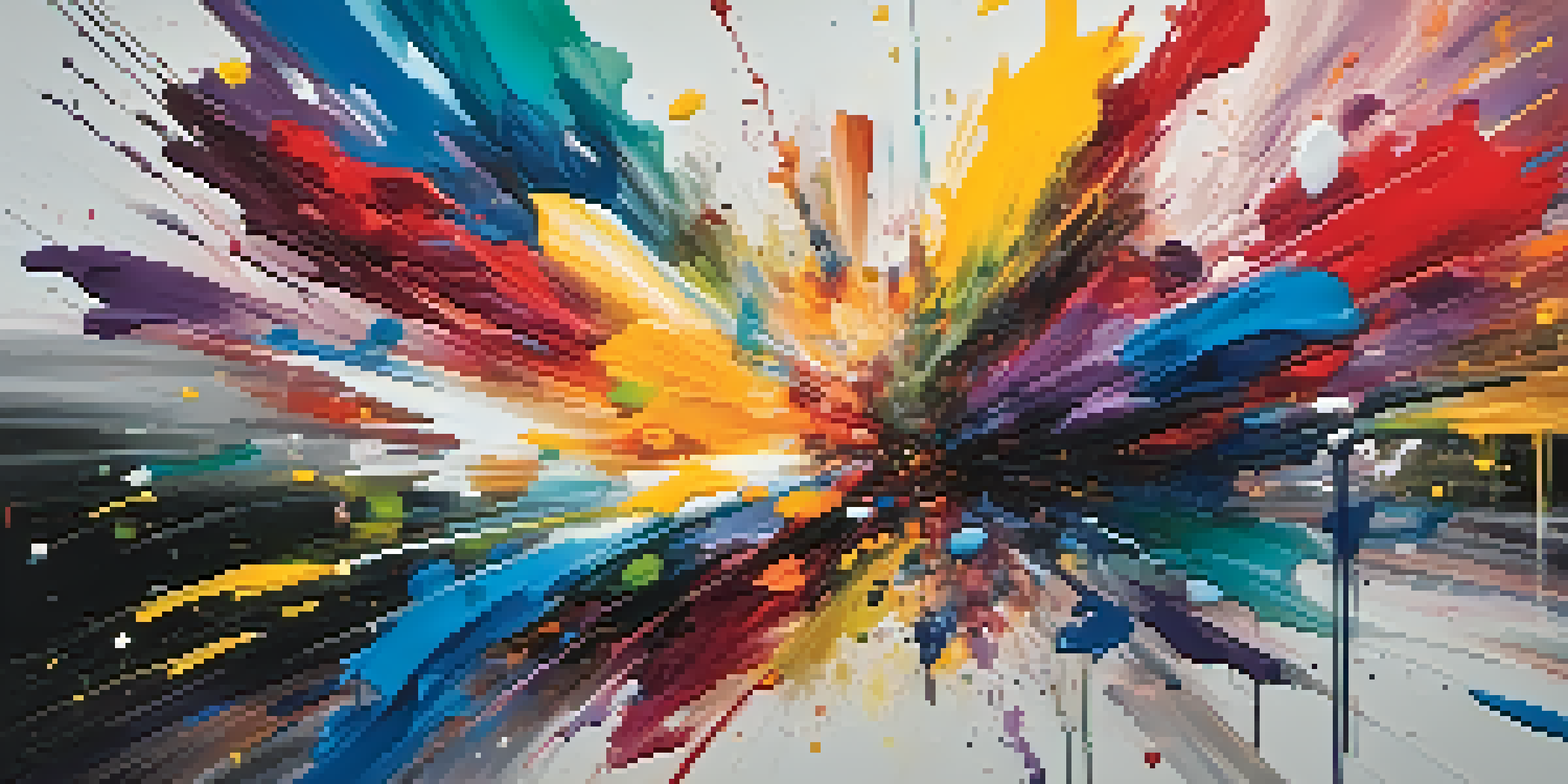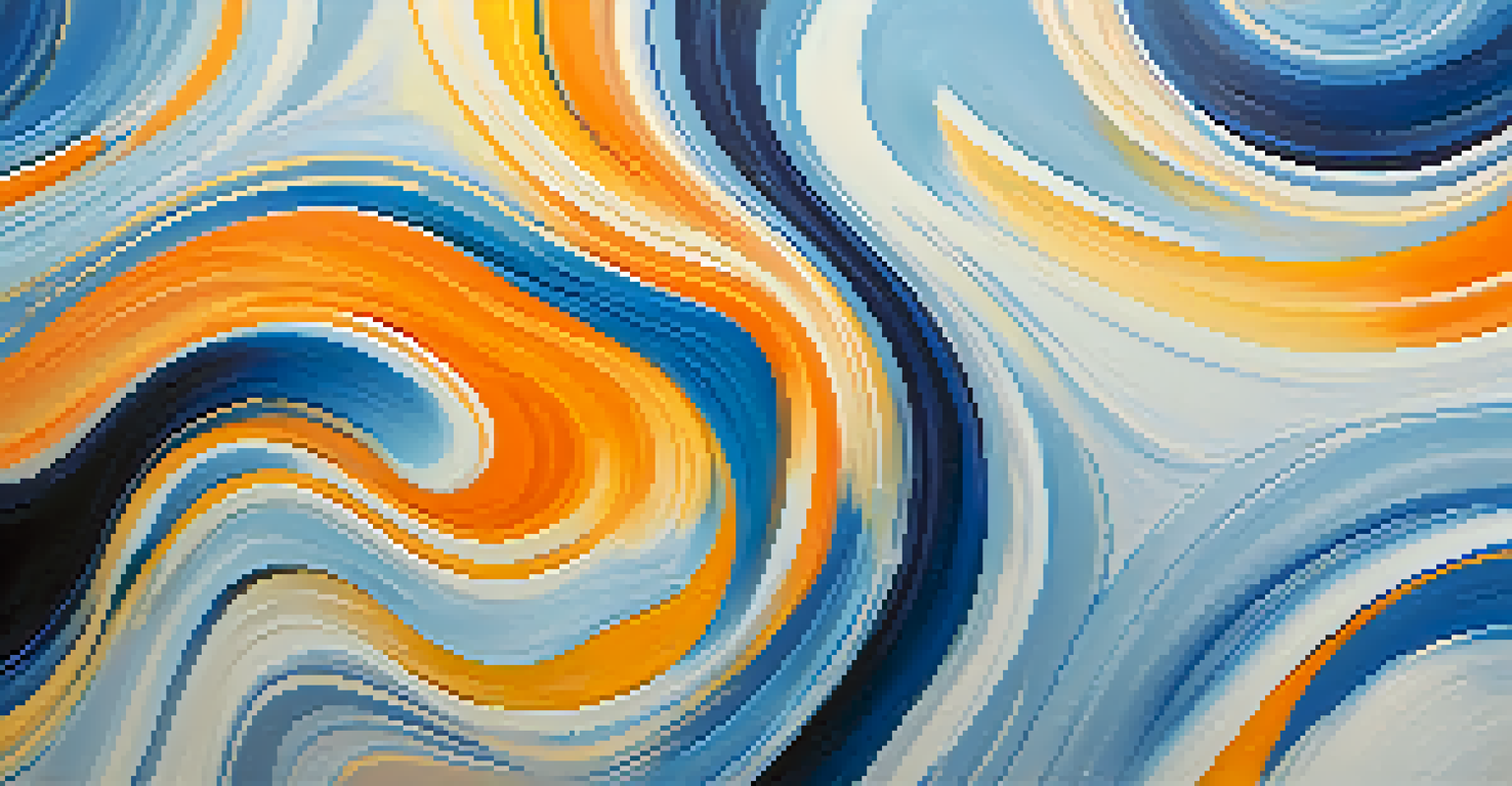The Origins of Abstract Painting: A Historical Perspective

Defining Abstract Painting and Its Core Concepts
Abstract painting is an artistic style that emphasizes shapes, colors, and forms rather than realistic depictions. At its core, it seeks to convey emotions and ideas without being tied to representational imagery. This form of art invites viewers to interpret meaning based on personal experiences and feelings, making it a unique encounter for everyone.
Color is the keyboard, the eyes are the harmonies, the soul is the piano with many strings.
The move towards abstraction can be seen as a reaction against the constraints of traditional art forms, where realism reigned. Artists began to experiment, pushing the boundaries of what art could be. This shift allowed for a more personal expression, where the artist's inner thoughts took center stage.
Understanding abstract painting involves recognizing its diverse influences, from Impressionism to Cubism. Each movement contributed to the evolution of abstraction, encouraging artists to explore new techniques and perspectives. This rich tapestry of influences laid the groundwork for what we now recognize as modern abstract art.
The Role of Impressionism in Shaping Abstraction
Impressionism emerged in the late 19th century, focusing on capturing the fleeting effects of light and color. While mainly representational, it introduced a sense of spontaneity that resonated with emerging abstract artists. The Impressionists' emphasis on personal perception paved the way for abstraction to take root in the art world.

Artists like Claude Monet and Pierre-Auguste Renoir began to explore the use of color and brushstroke in ways that emphasized mood over detail. This departure from traditional techniques encouraged others to see beyond the physical representation of objects. As artists embraced the notion of capturing an impression rather than a likeness, abstraction began to flourish.
Abstract Art's Emotional Journey
Abstract painting prioritizes emotions and personal interpretation over realistic representation, inviting viewers to engage uniquely with each work.
The impact of Impressionism is evident in the way it encouraged artists to break free from established norms. It opened the door to a more subjective approach to art, where feelings and sensations became the focal point. This shift was crucial in the journey toward a fully abstract artistic expression.
Cubism: A Pivotal Movement for Abstract Art
Cubism, pioneered by Pablo Picasso and Georges Braque in the early 20th century, revolutionized the way we perceive art. By deconstructing objects into geometric shapes and presenting multiple viewpoints simultaneously, Cubism challenged traditional perspectives. This radical approach laid the foundation for future abstract movements.
The more I paint, the more I feel that I am painting the way I see life, the way I feel it, and the way I want it to be.
The Cubists' desire to depict reality from various angles encouraged artists to think beyond conventional representation. Instead of focusing on the object itself, they explored the underlying structure and form. This emphasis on abstraction over realism signaled a turning point in the evolution of modern art.
Cubism also inspired a generation of artists to experiment with collage and mixed media, further pushing the boundaries of abstraction. The movement's innovative techniques and ideas contributed significantly to the development of non-representational art. It served as a catalyst for subsequent styles, reinforcing the notion that art could exist independently of the physical world.
The Influence of Expressionism on Abstract Art
Expressionism emerged in the early 20th century as a movement focused on conveying emotions and subjective experiences. Artists sought to express their feelings through bold colors, distorted forms, and exaggerated brushstrokes. This emotional intensity inspired many abstract artists to prioritize feeling over form.
Prominent figures like Wassily Kandinsky and Edvard Munch used color and composition to evoke deep emotional responses. Their work demonstrated that art could transcend mere representation, tapping into the artist's psyche. This exploration of emotion became a significant aspect of abstract painting, influencing its trajectory.
Key Movements Shaping Abstraction
Art movements like Impressionism, Cubism, and Expressionism played crucial roles in the evolution of abstract art, each contributing new techniques and perspectives.
The legacy of Expressionism can be seen in the way it encouraged artists to explore their inner worlds. By prioritizing emotional expression, these artists paved the way for abstract art to flourish. The connection between emotion and abstraction remains a fundamental theme in contemporary art practices today.
Abstract Art in the Early 20th Century: Key Figures
The early 20th century witnessed the rise of several influential abstract artists who left a lasting impact. Figures like Kazimir Malevich and Piet Mondrian championed the idea of pure abstraction, focusing on geometric forms and primary colors. Their work aimed to distill art to its essential elements, moving beyond representational constraints.
Malevich's 'Black Square' marked a radical departure from traditional art, embodying the concept of non-objective art. Mondrian's grid-based compositions emphasized balance and harmony, showcasing how abstraction could convey universal truths. These artists laid the groundwork for various abstract movements that followed.
Their pioneering efforts challenged perceptions of what art could be, encouraging future generations to push creative boundaries. The dedication to abstraction as a means of expression opened up new avenues for exploration in the art world. As a result, the early 20th century became a pivotal time for abstract painting's evolution.
The Impact of Surrealism on Abstract Painting
Surrealism, which emerged in the 1920s, sought to unlock the unconscious mind and explore dreams and fantasies. This movement had a profound influence on abstract painting by encouraging artists to delve into the irrational and the bizarre. Many abstract artists began incorporating surrealist elements into their work, creating dreamlike compositions.
Artists like Joan Miró and André Masson blurred the lines between reality and abstraction, using organic shapes and vibrant colors to evoke a sense of wonder. Their exploration of the subconscious allowed for a more fluid interpretation of abstract art, where spontaneity reigns. This interplay between surrealism and abstraction enriched the artistic landscape.
Modern Abstraction's Ongoing Innovation
Contemporary abstract artists continue to redefine the genre, employing innovative styles and materials to reflect the complexities of modern life.
Surrealism's emphasis on imagination and individual perception further expanded the possibilities for abstract artists. By exploring the depths of the mind, artists could express complex emotions and ideas that words often cannot capture. This connection between surrealism and abstraction continues to resonate in contemporary art practices.
Modern Abstract Art and Its Continued Evolution
Modern abstract art encompasses a wide range of styles and techniques, reflecting the diverse influences of the past century. From Abstract Expressionism to Minimalism, artists have continually redefined what abstraction means. This evolution showcases the limitless creativity and experimentation inherent in the genre.
Abstract Expressionism, led by artists like Jackson Pollock and Mark Rothko, emphasized the act of painting itself as a form of expression. Their large-scale canvases and dynamic brushwork invite viewers to engage with the work on a visceral level. This movement highlighted the importance of emotional authenticity in abstract art.

Today, contemporary abstract artists continue to push boundaries, exploring new materials and technologies. The genre remains a vibrant space for innovation, allowing artists to express their unique perspectives. As we look to the future, abstract painting will undoubtedly continue to evolve, reflecting the complexities of our ever-changing world.